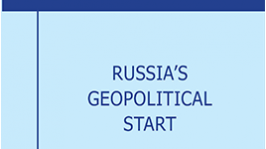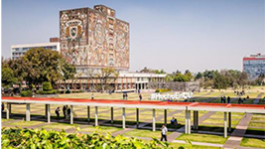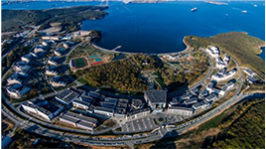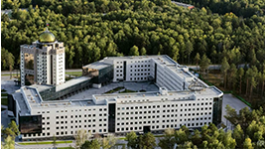Неэргодическая экономика
Авторский аналитический Интернет-журнал
Изучение широкого спектра проблем экономики
На английском языке
The book considers objective principles, rules, laws, mechanisms and effects underlying the dynamics of recurrent change of global capital accumulation centers. The work reveals the fallacy of the concept of multipolarity and proves that the global geopolitical space is governed by the principle of monocentricity. The book aims to prove that today’s Russia possesses unique geopolitical advantages compared to all other nation–states, and can claim the role of a new center of capital and a new center of global activity. Based on a unified general scientific perspective, the author reveals many issues that have been overlooked in the current academic discourse: the emergence of the ideology of transhumanism, the functioning of the neo–colonialism system, features of hybrid wars, crystallization of the passionarity of the people, etc. The book can be useful to anyone interested in international relations and world politics.
11.05.2023
This study examines how internal research and development (R&D), external knowledge acquisition, and R&D contracted with other companies interact in local and foreign–owned enterprises in post–communist economies. A large sample of firm–level data from the Business Environment and Enterprise Performance Survey (BEEPS) across 26 postcommunist countries (including European Union (EU) members and non–EU states of Eastern Europe, Caucasian countries, and Central Asian countries) and country–level data from the Global Innovation Index and the International Property Rights Index were used. The findings show that enterprises with majority foreign ownership are relatively more likely to acquire external R&D. We demonstrate that the R&D behavior of enterprises with majority foreign ownership and local firms are interrelated, that is, we find a synergy effect. According to the results, decisions on internal R&D and the purchase of external knowledge for enterprises with majority foreign ownership are similar to those of local firms. However, enterprises with foreign ownership contract R&D with other companies more often if local firms conduct internal R&D. These results indicate the presence of knowledge spillover and cross–learning effects in both types of enterprises in postcommunist countries. Finally, we find that the national innovation environment is not significant for the R&D intensity of enterprises with majority foreign ownership, which suggests their high dependence on the parent structures of multinational enterprises.
01.05.2023
Based on the sociological surveys “Scientific Policy of Russia,” conducted in 2021 and 2022, widespread opinions in the scientific community regarding the external openness of Russian civil science are analyzed. It is noted that the sustainable vector of state policy to maintain a high level of integration of domestic science into the international scientific space was suddenly called into question after the start of the special military operation of the Russian Federation in Ukraine. The decades–long Western–oriented course of Russian science has formed strong support among researchers, which, as it turned out, is very difficult for scientists to abandon abruptly even in the new conditions. It has been established that the sanctions imposed against Russian science turned out to be quite painful, and their consequences can only be overcome in the long term.
01.05.2023
The article considers the current state of economic science and the methodological contradictions accumulated in its depths. The central thesis is the paradox of science, according to which meeting all the strict criteria of scientificity does not allow the current economic knowledge to give an effective response to the challenges of modernity. In order to substantiate this paradox, four attributes of the scientific nature of economics have been considered: theoretical, observational, inductive (historical) and experimental. Seven groups of objective causes provoking the decline in the practical relevance of economics were investigated in parallel. The emergence of the paradox of science against the background of long–term failures of economic science in explaining and predicting the key events of modernity indicates that for over 30 years it has been in a global methodological deadlock, in which one can stay indefinitely, rather than in a crisis that is resolved sooner or later. Therefore, a new social science – socionomics – needs to be created. Such attempts have been repeatedly made, but failed. Consideration of the methodological features of tectology, cybernetics, general systems theory and synergetics allows us to understand the reasons for these failures: identifying systems of different nature and assuming the universality of the laws to which they obey. The article shows new attempts of interdisciplinary research in Russia aimed at revealing deep analogies between structural patterns in physics, chemistry, biology and informatics and spatio–temporal archetypes (hexagrams) in the Chinese “Book of Changes” (“I Ching”). The author has revealed the reasons why these studies do not lead to final success in spite of their obvious fruitfulness: “The Book of Changes” operates with content and form of the phenomenon, but not with its scale, which gives the illusion of accuracy, but does not allow to make practically significant calculations. The contours of a new science – socionomics – are outlined.
11.02.2023
The article discusses mechanisms that are put into action during the hybrid war of civilizations that has unfolded at the present time. For this purpose, the concepts of two antagonistic megacivilizations – the West and the Non–West – have been introduced. We reveal the essence and genesis of the First and Second civilizational failures within Western civilization, reconstruct the anatomy of destruction of the national model of Russia’s social development after 1991 under the influence of the neocolonial governance system. We uncover and interpret the paradox of the lag in the development of the two megacivilizations, look into the genesis of the passionarity of the ethnos, and substantiate the primacy of geopolitical logic over economic logic. We provide an outlook of the current hybrid war between the West and the Non–West. The novelty of our approach consists in combining the knowledge of different sciences to explain social processes during the period of geopolitical turbulence. We look into philosophical phenomena (opposite dynamics of the material and spiritual spheres), cybernetic (full and partial cybernetic inversions), historical (birth of ethnic passionarity), political (hybrid wars), biological (neuroplasticity of the brain), cultural (cultural plasticity of civilization), economic (world currency, phenomenon of superprofits) factors. This made it possible to correlate objective and subjective factors in the confrontation between the two megacivilizations. The main conclusion of the study is that neither the West (USA) nor the Non–West (Russia) has clear advantages in the unfolding hybrid war of civilizations. The tactical superiority of the West is opposed to the strategic superiority of the Non–West; this situation does not allow us to make unambiguous predictions about the future winner.
27.01.2023
The article deals with the problem of identifying world–class universities (WCU) on the basis of information provided by various ranking systems. The relevance of the problem is due to the fact that in 2022 Russia was “cut off” from the world community, including the interruption of cooperation with leading international ranking universities, so the country risks losing the opportunity to self–check its successes and failures by generally recognized criteria. In this regard, the purpose of this article is hypothesis verification that the “friendly” ranking of ARWU base can serve as an effective substitute for the “unfriendly” OS ranking base. To test the formulated hypothesis, we used the previously developed algorithm for identifying WCU using statistical data from the five Global University Rankings – Ouacquarelli Symonds (OS), Times Higher Education (THE), Academic Ranking of World Universities (ARWU), Center for World University Rankings (CWUR) and National Taiwan University Ranking (NTU) – and two University Rankings by subject – OS and ARWU. Conducted calculations disproved the general hypothesis and revealed a fundamental inconsistency of results obtained on the basis of different rankings. In addition, by the example of the ARWU, a profound contradiction in the logic of compiling the GUR and the SRU was uncovered. That raises a broader question about adequacy of the concept of the WCU itself. To answer this question, we conducted a “humanitarian test” for the validity of modern WCU, which showed the presence of elementary illiteracy and lack of culture among graduates of advanced universities. Collected stylized examples allowed to establish that modern world market leaders’ universities do not pass the “humanitarian test”, and therefore the entire rating system cannot be considered a reliable basis for conclusions about the activities of universities. The question of replacing the term WCU with a less pretentious “product” category – practice–oriented universities – is being discussed.
04.01.2023
The paper investigates a set of factors contributing to Russia’s transformation into a new world capital accumulation center in the next two to three decades. The novelty of our approach lies in the fact that we consider the current phase of global geopolitical turbulence through the prism of the capital accumulation cycles theory in order to determine the vector of future development of the world economic system. We dig into the topic by forming a comprehensive picture of Russia’s potential advantages that are quite versatile. Thus, we look into the following phenomena: geographical (ice decline in the Russian Arctic; Russia evolving from a land power into a sea power; natural resources endowment), philosophical (dialectical confrontation of homogeneity and heterogeneity of the world system), historical (syndrome of false contender for the role of a world capital accumulation center; passionarity of the ethnos), political (parade of sovereignties and imperial revanchists, diffusion of the nuclear syndrome, legitimization of the struggle against political and managerial opposition), political economy (cycles of capital accumulation; world capital accumulation center; Russia’s economy joining the world system of capitalism), economic (effectiveness of international economic sanctions; general–purpose technologies; industry cycles; regulatory and technology triads), demographic (demographic curse), cultural (openness of the Russian Civilization to immigrants, its civilizing experience in relation to other peoples, high civilizational absorption), military (latent and active phases of hybrid warfare; hybrid warfare paradox), factors and management effects (autonomous and authoritarian management, hegemon and leader models). This helped us to reconstruct the system of checks and balances formed around the Russian Federation in the hybrid warfare between the West and the Non–West. We deepen the analysis by providing our own interpretation of sea states and land states. The main conclusion of the research is that Russia possesses unique geopolitical advantages that allow it to successfully counteract the Collective West and eventually become a new leader of the world economic system.
25.11.2022
The article is devoted to the disclosure of the concept of the global university market and the rationale for the need to abandon the idea of a world–class university (WCU) the concept is based on. The authors have shown that in 2022, due to increased global geopolitical turbulence, the global university market began to split into local (regional) segments, and the consensus reached in the previous two decades on the criteria for leading universities was finally broken. The paper notes that the confrontation between the West and the East, which worsened in 2022, led to the destruction of the US monopoly in the higher education market and the transformation of a homogeneous university market into a heterogeneous one, for which the WCU concept loses its former meaning. This is largely due to the denial of the former role of global university rankings, which have become completely irrelevant under international sanctions with the accompanying phenomenon of scientific ostracism of individual countries. The authors prove that the system of international university rankings leads to the formation of the effect of false prestige, when the scientific achievements of the United States and Europe are unduly exaggerated, including by imposing false ideologemes and mythologemes regarding progressive organizational models of universities. As an alternative to the WCU, the authors propose a concept of Higher Class University (HCU), which is based on the closest connection of the university with the high–tech sectors of the national economy through its participation in research and production and experimental projects of the country’s leading companies. The article shows that the new concept and the adoption of the construction of a HCU set as the goal of modernizing the system of higher education in Russia leads to revolutionary changes in the organizational model of domestic universities. The authors have considered the most important aspects in the field of personnel policy during the HCUs creation.
23.10.2022
The geopolitical turbulence dictates the need to transform the science and education sphere and reconsider the role of universities in today’s world. The article deals with the issue of defining and identifying world–class universities (WCU) and their connection with the technological development of the countries, where they are located. In particular, the research considers the problem of the validity (adequacy) of the WCU rankings. Methodologically, the study relies on the global and subject rankings of universities compiled by leading rating agencies. The paper proposes a modified algorithm to increase the accuracy of the WCU identification. For the applied calculations, the paper uses data from five ranking products: Quacquarelli Symonds (QS), Times Higher Education (THE), Academic Ranking of World Universities (ARWU), Center for World University Rankings (CWUR) and National Taiwan University Ranking (NTU). According to the results, Russia has only one WCU, which is at the stage of losing this status. In order to check the validity of the list of WCU, the research suggests the validity index that takes into account the completeness of the representation of universities of the Nuclear Club countries in the above list. Calculations demonstrate that this index amounts to 43.3 %, which indicates that modern rating sources of information perform extremely poorly for Russia and Asian countries. The research concludes that the existing ideas about WCU, as well as the methods for their identification, no longer correspond to the new realities, and insists that the central property of WCU should be direct participation in real high–tech projects of the highest (world) level and a significant contribution made due to this to the development of the national economy.
13.10.2022
According to a general social development theory postulate called the consistency principle, the economic growth rate depends not only upon technological, institutional, and cultural progress, but also upon the degree of consistency between these factor groups. The paper formalizes and verifies this hypothesis by applying econometric models to a sample of 154 countries. GDP growth rate was used as the output variable, and technologies, institutions, and culture quantified via proxy variables of labor productivity, Doing Business, and Corruption Perception Indices, respectively, as input ones. A fixed effect model was built on this basis, with explanatory variables’ coefficients adjusted by means of covariance–dispersion matrices. The empirical calculations confirmed the validity of the consistency principle for a group of rich countries (with above the average per capita income), but not for a group of poor countries with per capita income below the average. The obtained results were interpreted in terms of Acemoglu–Robinson’s “narrow corridor” and the structural competition concepts and the self–organization theory. It is shown that in the scope of the Acemoglu–Robinson concept, the consistency principle becomes a necessary condition for the occurrence of the Red Queen effect.
30.09.2022












